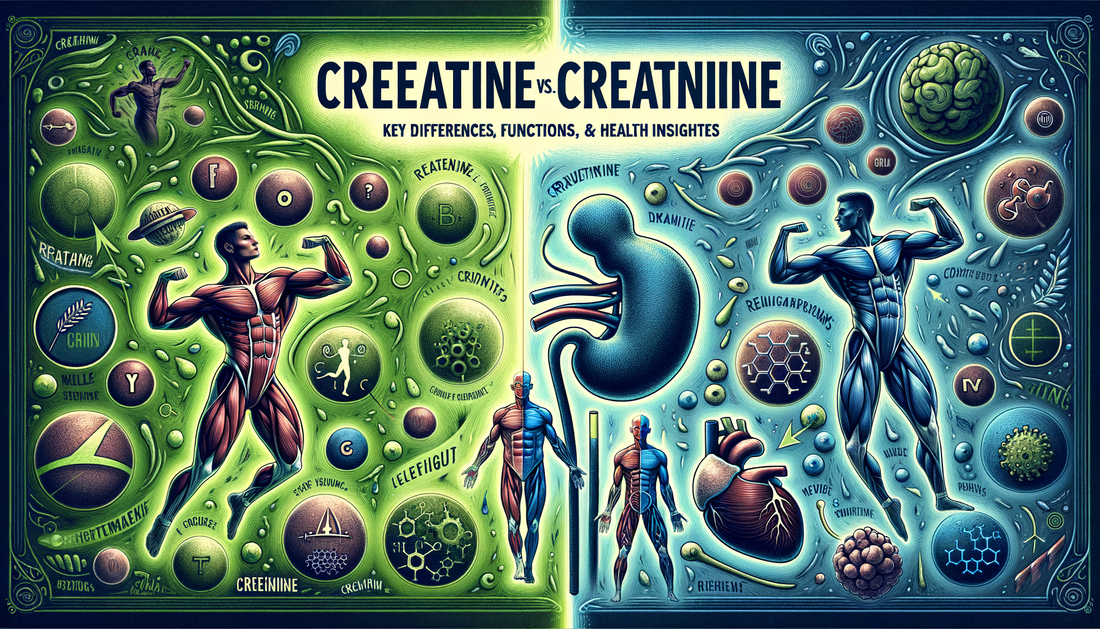- What Is Creatine?
- What Is Creatinine?
- Key Differences Between Creatine and Creatinine
- Functions of Creatine in the Body
- Health Insights: Creatine vs. Creatinine
- Why Creatine Gummy Manufacturing Matters
- Final Thoughts on Creatine vs. Creatinine
What Is Creatine?
Creatine is a naturally occurring compound found in small amounts within the muscle cells of the human body. It's derived from amino acids and plays a key role in energy production, particularly during high-intensity exercises like weightlifting or sprinting.
Many athletes and fitness enthusiasts supplement with creatine to boost their performance. This compound helps regenerate adenosine triphosphate (ATP), which acts as the primary energy source for muscle contractions. A popular form of supplementation is creatine monohydrate, known for its effectiveness and affordability. For those looking for an innovative and convenient way to supplement their creatine, Wild Gainz Creatine Gummies are an excellent option.
What Is Creatinine?
While "creatinine" sounds similar to "creatine," it’s an entirely different substance. Creatinine is a metabolic byproduct formed as a result of the natural breakdown of creatine in the body. Once created, creatinine is filtered out of your blood by the kidneys and excreted in your urine.
Doctors frequently measure creatinine levels in blood and urine as an indicator of kidney function. Elevated levels can sometimes signal underlying health issues related to kidney disease, dehydration, or muscle damage.
Key Differences Between Creatine and Creatinine
While creatine and creatinine are directly linked, their roles and significance in the body are drastically different. Here's a comparison:
- Origin: Creatine is ingested through diet or supplements, whereas creatinine is naturally formed when your body metabolizes creatine.
- Function: Creatine plays a role in energy production and muscle performance. Creatinine, on the other hand, serves no physiological purpose—it’s simply a waste product.
- Health Interpretation: High creatine levels are usually advantageous for performance, while high creatinine levels may indicate potential health issues.
Understanding the differences between the two is crucial, as they impact the body in very distinct ways.
Functions of Creatine in the Body
Creatine plays multiple important roles in improving overall fitness and athleticism. Here’s a closer look at its primary functions:
1. Boosting Energy Production
Creatine is directly tied to enhanced ATP production. During short bursts of high-intensity exercise, it provides your cells with the necessary energy to support muscle contractions.
2. Enhancing Muscle Mass
Creatine supplementation has been consistently shown to enhance muscle size and strength. It increases water retention in the muscles, creating a fuller appearance while also contributing to lean muscle growth.
3. Improving Exercise Performance
Numerous studies point to improved workout outcomes with creatine supplementation. It can increase power output, reduce fatigue, and help you train harder for longer.
4. Supporting Cognitive Function
Emerging research suggests creatine may have a positive impact on brain health by improving energy metabolism within brain cells. This could potentially enhance mental clarity, focus, and memory.
Health Insights: Creatine vs. Creatinine
Let’s explore health-related takeaways when comparing creatine vs. creatinine.
Creatine: Safety and Supplementation
Creatine is one of the most extensively studied supplements available and is generally considered safe when used as directed. It offers numerous benefits, particularly for athletes and active individuals aiming to enhance their performance and recovery. However, proper hydration is key to ensuring optimal absorption and preventing any stress on your kidneys.
Creatinine: An Indicator, Not a Supplement
Unlike creatine, creatinine has no supplementation benefits. Elevated creatinine levels in blood tests are often used to diagnose health concerns. It’s worth noting, though, that increased creatinine levels can sometimes arise from intense exercise or a high-protein diet, which are frequently observed among fitness enthusiasts.
Why Creatine Gummy Manufacturing Matters
Not all creatine supplements are created equal, and this is especially true for new formats like gummies. Poor manufacturing processes can lead to creatine degrading into creatinine, rendering it far less effective and potentially causing unwanted side effects.
Exposure to heat or water during production can accelerate this conversion. This is why it’s critical to choose a high-quality product like Wild Gainz Creatine Gummies, which are carefully manufactured to preserve the integrity of creatine and ensure maximum effectiveness.
Final Thoughts on Creatine vs. Creatinine
In the debate of “creatine vs creatinine,” understanding their differences is paramount. While creatine serves as a powerful tool for boosting athletic performance, creatinine is simply a waste product that helps gauge kidney function.
Choosing the right creatine supplement is critical to achieving optimal results. Proper manufacturing, as seen with Wild Gainz Creatine Gummies, ensures the supplement retains its efficacy without breaking down into creatinine prematurely.
Still curious about how creatine supplementation can support your fitness journey? Be sure to explore our full collection of creatine-related articles for more insights. Take your workouts to the next level with the support of high-quality creatine from Wild Gainz.

